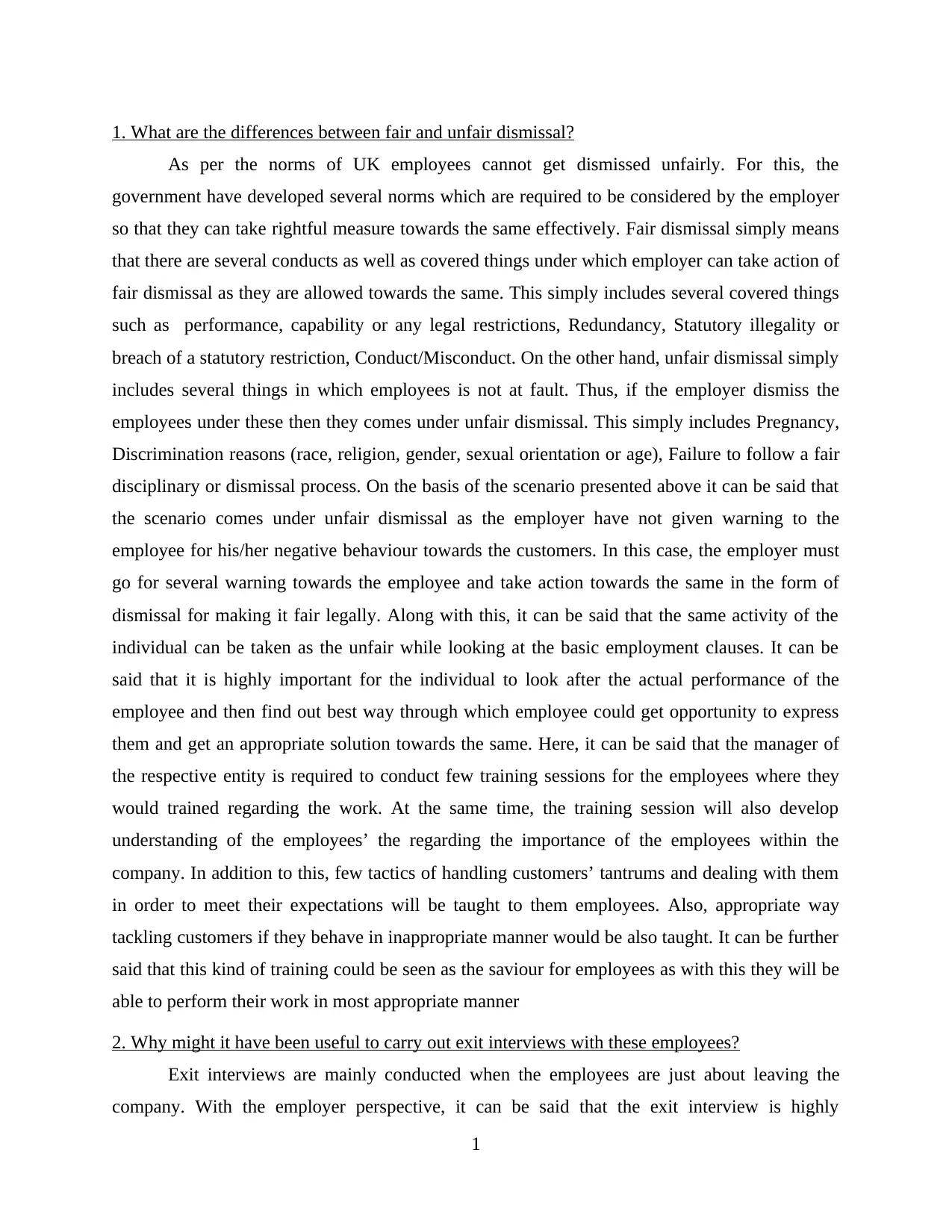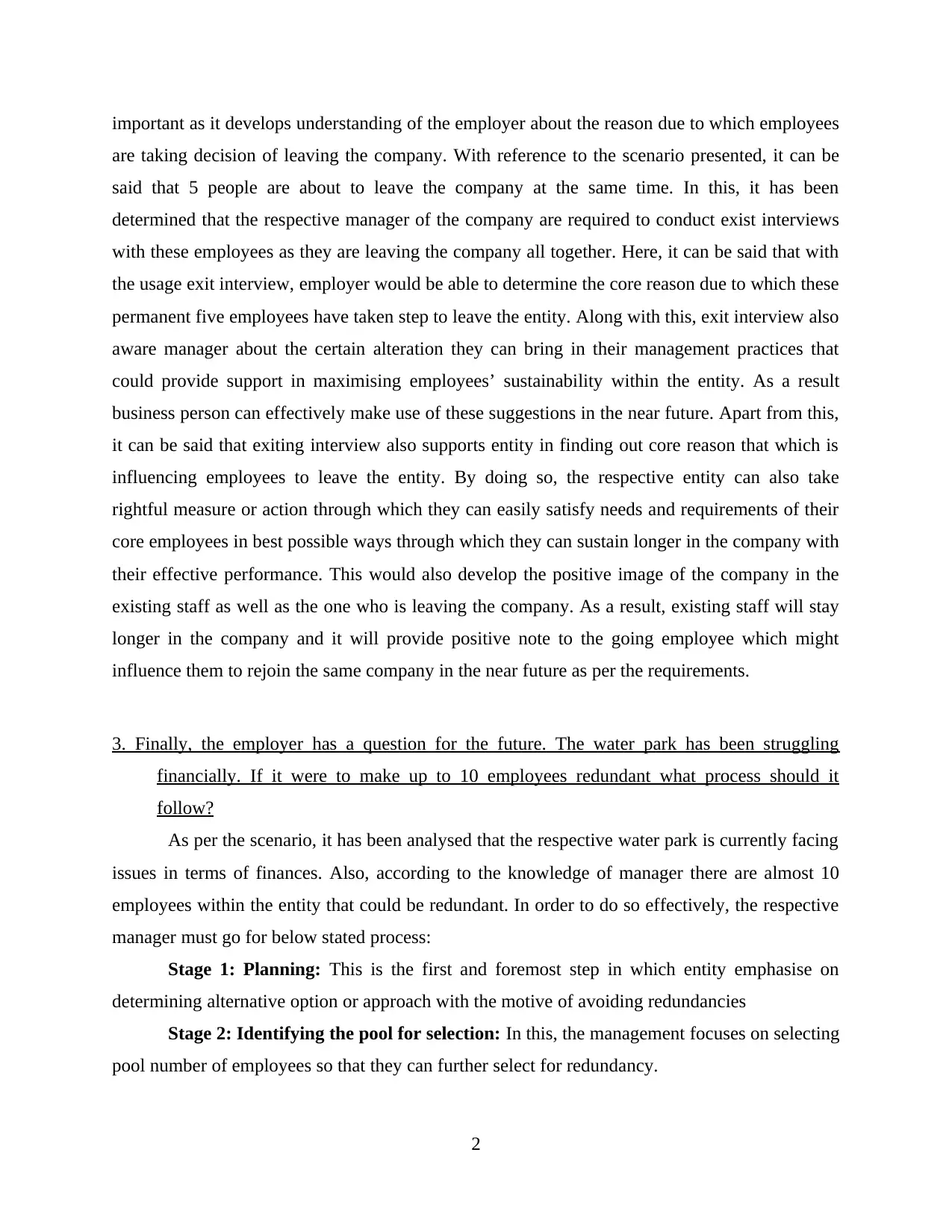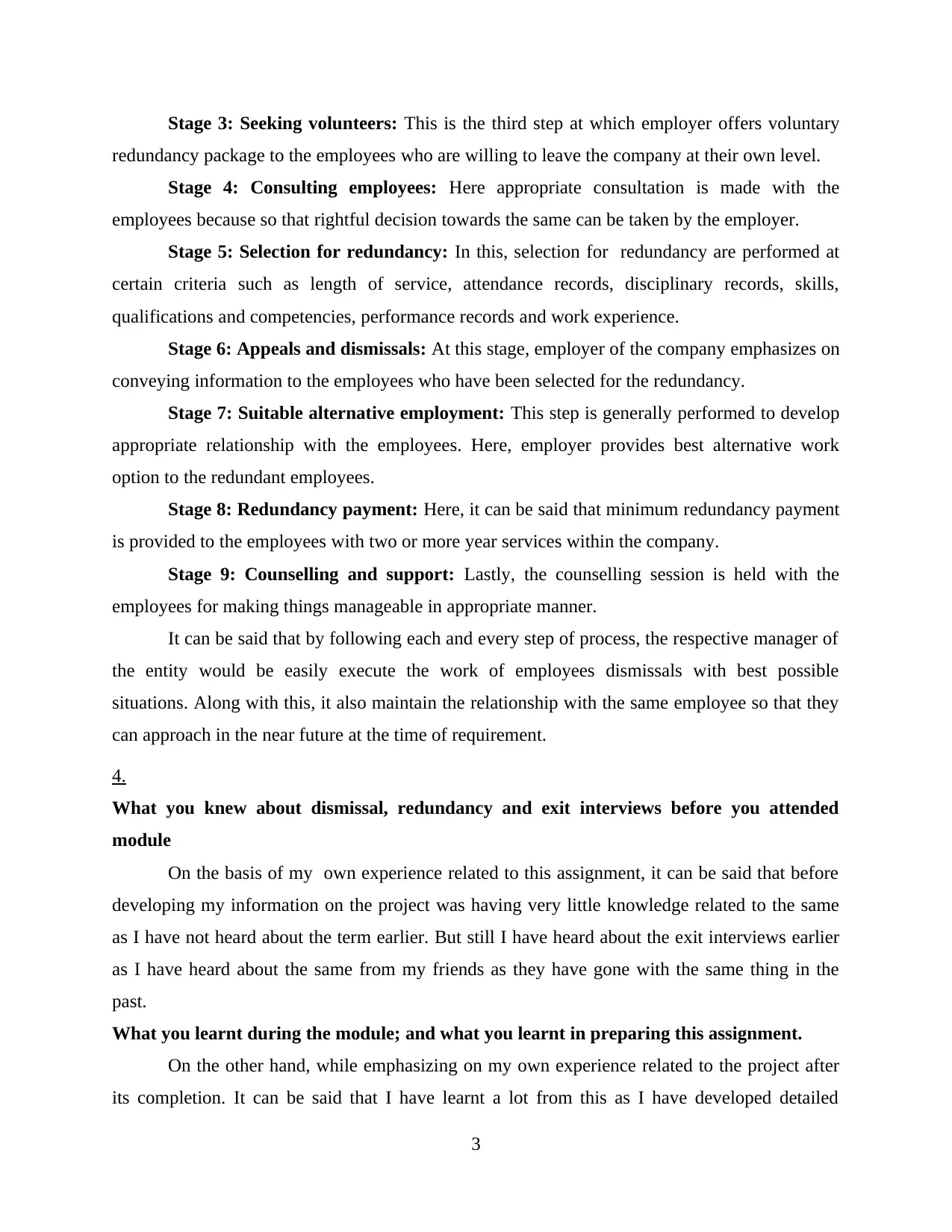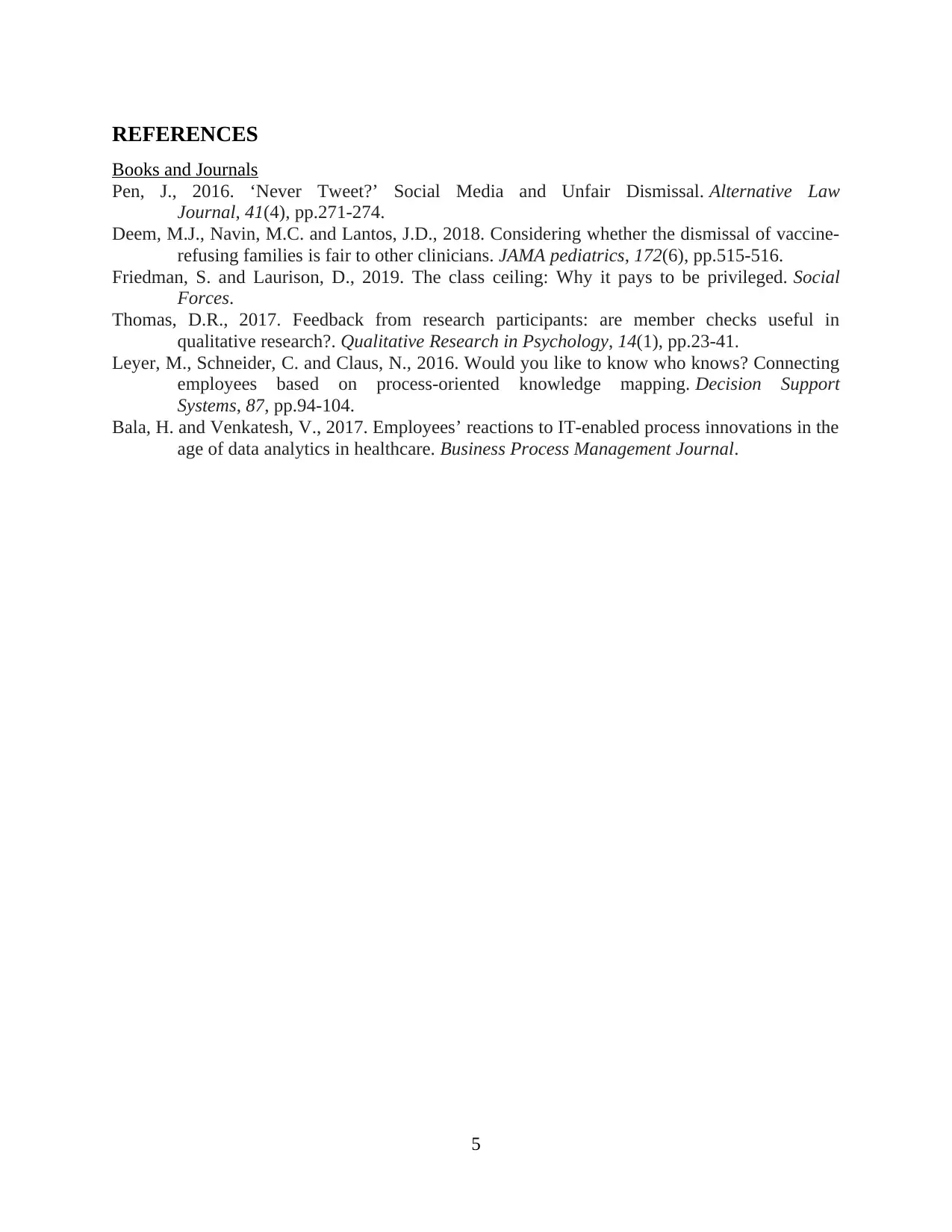HRP55D 3MERC: Analysis of Dismissal, Redundancy, and Exit Interviews
VerifiedAdded on 2023/01/10
|7
|1637
|27
Report
AI Summary
This report analyzes a scenario involving a water park facing employee issues and financial struggles. It differentiates between fair and unfair dismissal, highlighting the importance of following proper procedures and providing warnings before termination. The report emphasizes the significance of exit interviews in understanding employee turnover and improving management practices. It also outlines the steps a company should take when making employees redundant, including planning, selection, consultation, and providing support. Finally, the report reflects on the student's learning experience, detailing their prior knowledge and the insights gained from completing the assignment and studying the module material, including the references used.

HRP55D 3MERC
Paraphrase This Document
Need a fresh take? Get an instant paraphrase of this document with our AI Paraphraser

Table of Contents

1. What are the differences between fair and unfair dismissal?
As per the norms of UK employees cannot get dismissed unfairly. For this, the
government have developed several norms which are required to be considered by the employer
so that they can take rightful measure towards the same effectively. Fair dismissal simply means
that there are several conducts as well as covered things under which employer can take action of
fair dismissal as they are allowed towards the same. This simply includes several covered things
such as performance, capability or any legal restrictions, Redundancy, Statutory illegality or
breach of a statutory restriction, Conduct/Misconduct. On the other hand, unfair dismissal simply
includes several things in which employees is not at fault. Thus, if the employer dismiss the
employees under these then they comes under unfair dismissal. This simply includes Pregnancy,
Discrimination reasons (race, religion, gender, sexual orientation or age), Failure to follow a fair
disciplinary or dismissal process. On the basis of the scenario presented above it can be said that
the scenario comes under unfair dismissal as the employer have not given warning to the
employee for his/her negative behaviour towards the customers. In this case, the employer must
go for several warning towards the employee and take action towards the same in the form of
dismissal for making it fair legally. Along with this, it can be said that the same activity of the
individual can be taken as the unfair while looking at the basic employment clauses. It can be
said that it is highly important for the individual to look after the actual performance of the
employee and then find out best way through which employee could get opportunity to express
them and get an appropriate solution towards the same. Here, it can be said that the manager of
the respective entity is required to conduct few training sessions for the employees where they
would trained regarding the work. At the same time, the training session will also develop
understanding of the employees’ the regarding the importance of the employees within the
company. In addition to this, few tactics of handling customers’ tantrums and dealing with them
in order to meet their expectations will be taught to them employees. Also, appropriate way
tackling customers if they behave in inappropriate manner would be also taught. It can be further
said that this kind of training could be seen as the saviour for employees as with this they will be
able to perform their work in most appropriate manner
2. Why might it have been useful to carry out exit interviews with these employees?
Exit interviews are mainly conducted when the employees are just about leaving the
company. With the employer perspective, it can be said that the exit interview is highly
1
As per the norms of UK employees cannot get dismissed unfairly. For this, the
government have developed several norms which are required to be considered by the employer
so that they can take rightful measure towards the same effectively. Fair dismissal simply means
that there are several conducts as well as covered things under which employer can take action of
fair dismissal as they are allowed towards the same. This simply includes several covered things
such as performance, capability or any legal restrictions, Redundancy, Statutory illegality or
breach of a statutory restriction, Conduct/Misconduct. On the other hand, unfair dismissal simply
includes several things in which employees is not at fault. Thus, if the employer dismiss the
employees under these then they comes under unfair dismissal. This simply includes Pregnancy,
Discrimination reasons (race, religion, gender, sexual orientation or age), Failure to follow a fair
disciplinary or dismissal process. On the basis of the scenario presented above it can be said that
the scenario comes under unfair dismissal as the employer have not given warning to the
employee for his/her negative behaviour towards the customers. In this case, the employer must
go for several warning towards the employee and take action towards the same in the form of
dismissal for making it fair legally. Along with this, it can be said that the same activity of the
individual can be taken as the unfair while looking at the basic employment clauses. It can be
said that it is highly important for the individual to look after the actual performance of the
employee and then find out best way through which employee could get opportunity to express
them and get an appropriate solution towards the same. Here, it can be said that the manager of
the respective entity is required to conduct few training sessions for the employees where they
would trained regarding the work. At the same time, the training session will also develop
understanding of the employees’ the regarding the importance of the employees within the
company. In addition to this, few tactics of handling customers’ tantrums and dealing with them
in order to meet their expectations will be taught to them employees. Also, appropriate way
tackling customers if they behave in inappropriate manner would be also taught. It can be further
said that this kind of training could be seen as the saviour for employees as with this they will be
able to perform their work in most appropriate manner
2. Why might it have been useful to carry out exit interviews with these employees?
Exit interviews are mainly conducted when the employees are just about leaving the
company. With the employer perspective, it can be said that the exit interview is highly
1
⊘ This is a preview!⊘
Do you want full access?
Subscribe today to unlock all pages.

Trusted by 1+ million students worldwide

important as it develops understanding of the employer about the reason due to which employees
are taking decision of leaving the company. With reference to the scenario presented, it can be
said that 5 people are about to leave the company at the same time. In this, it has been
determined that the respective manager of the company are required to conduct exist interviews
with these employees as they are leaving the company all together. Here, it can be said that with
the usage exit interview, employer would be able to determine the core reason due to which these
permanent five employees have taken step to leave the entity. Along with this, exit interview also
aware manager about the certain alteration they can bring in their management practices that
could provide support in maximising employees’ sustainability within the entity. As a result
business person can effectively make use of these suggestions in the near future. Apart from this,
it can be said that exiting interview also supports entity in finding out core reason that which is
influencing employees to leave the entity. By doing so, the respective entity can also take
rightful measure or action through which they can easily satisfy needs and requirements of their
core employees in best possible ways through which they can sustain longer in the company with
their effective performance. This would also develop the positive image of the company in the
existing staff as well as the one who is leaving the company. As a result, existing staff will stay
longer in the company and it will provide positive note to the going employee which might
influence them to rejoin the same company in the near future as per the requirements.
3. Finally, the employer has a question for the future. The water park has been struggling
financially. If it were to make up to 10 employees redundant what process should it
follow?
As per the scenario, it has been analysed that the respective water park is currently facing
issues in terms of finances. Also, according to the knowledge of manager there are almost 10
employees within the entity that could be redundant. In order to do so effectively, the respective
manager must go for below stated process:
Stage 1: Planning: This is the first and foremost step in which entity emphasise on
determining alternative option or approach with the motive of avoiding redundancies
Stage 2: Identifying the pool for selection: In this, the management focuses on selecting
pool number of employees so that they can further select for redundancy.
2
are taking decision of leaving the company. With reference to the scenario presented, it can be
said that 5 people are about to leave the company at the same time. In this, it has been
determined that the respective manager of the company are required to conduct exist interviews
with these employees as they are leaving the company all together. Here, it can be said that with
the usage exit interview, employer would be able to determine the core reason due to which these
permanent five employees have taken step to leave the entity. Along with this, exit interview also
aware manager about the certain alteration they can bring in their management practices that
could provide support in maximising employees’ sustainability within the entity. As a result
business person can effectively make use of these suggestions in the near future. Apart from this,
it can be said that exiting interview also supports entity in finding out core reason that which is
influencing employees to leave the entity. By doing so, the respective entity can also take
rightful measure or action through which they can easily satisfy needs and requirements of their
core employees in best possible ways through which they can sustain longer in the company with
their effective performance. This would also develop the positive image of the company in the
existing staff as well as the one who is leaving the company. As a result, existing staff will stay
longer in the company and it will provide positive note to the going employee which might
influence them to rejoin the same company in the near future as per the requirements.
3. Finally, the employer has a question for the future. The water park has been struggling
financially. If it were to make up to 10 employees redundant what process should it
follow?
As per the scenario, it has been analysed that the respective water park is currently facing
issues in terms of finances. Also, according to the knowledge of manager there are almost 10
employees within the entity that could be redundant. In order to do so effectively, the respective
manager must go for below stated process:
Stage 1: Planning: This is the first and foremost step in which entity emphasise on
determining alternative option or approach with the motive of avoiding redundancies
Stage 2: Identifying the pool for selection: In this, the management focuses on selecting
pool number of employees so that they can further select for redundancy.
2
Paraphrase This Document
Need a fresh take? Get an instant paraphrase of this document with our AI Paraphraser

Stage 3: Seeking volunteers: This is the third step at which employer offers voluntary
redundancy package to the employees who are willing to leave the company at their own level.
Stage 4: Consulting employees: Here appropriate consultation is made with the
employees because so that rightful decision towards the same can be taken by the employer.
Stage 5: Selection for redundancy: In this, selection for redundancy are performed at
certain criteria such as length of service, attendance records, disciplinary records, skills,
qualifications and competencies, performance records and work experience.
Stage 6: Appeals and dismissals: At this stage, employer of the company emphasizes on
conveying information to the employees who have been selected for the redundancy.
Stage 7: Suitable alternative employment: This step is generally performed to develop
appropriate relationship with the employees. Here, employer provides best alternative work
option to the redundant employees.
Stage 8: Redundancy payment: Here, it can be said that minimum redundancy payment
is provided to the employees with two or more year services within the company.
Stage 9: Counselling and support: Lastly, the counselling session is held with the
employees for making things manageable in appropriate manner.
It can be said that by following each and every step of process, the respective manager of
the entity would be easily execute the work of employees dismissals with best possible
situations. Along with this, it also maintain the relationship with the same employee so that they
can approach in the near future at the time of requirement.
4.
What you knew about dismissal, redundancy and exit interviews before you attended
module
On the basis of my own experience related to this assignment, it can be said that before
developing my information on the project was having very little knowledge related to the same
as I have not heard about the term earlier. But still I have heard about the exit interviews earlier
as I have heard about the same from my friends as they have gone with the same thing in the
past.
What you learnt during the module; and what you learnt in preparing this assignment.
On the other hand, while emphasizing on my own experience related to the project after
its completion. It can be said that I have learnt a lot from this as I have developed detailed
3
redundancy package to the employees who are willing to leave the company at their own level.
Stage 4: Consulting employees: Here appropriate consultation is made with the
employees because so that rightful decision towards the same can be taken by the employer.
Stage 5: Selection for redundancy: In this, selection for redundancy are performed at
certain criteria such as length of service, attendance records, disciplinary records, skills,
qualifications and competencies, performance records and work experience.
Stage 6: Appeals and dismissals: At this stage, employer of the company emphasizes on
conveying information to the employees who have been selected for the redundancy.
Stage 7: Suitable alternative employment: This step is generally performed to develop
appropriate relationship with the employees. Here, employer provides best alternative work
option to the redundant employees.
Stage 8: Redundancy payment: Here, it can be said that minimum redundancy payment
is provided to the employees with two or more year services within the company.
Stage 9: Counselling and support: Lastly, the counselling session is held with the
employees for making things manageable in appropriate manner.
It can be said that by following each and every step of process, the respective manager of
the entity would be easily execute the work of employees dismissals with best possible
situations. Along with this, it also maintain the relationship with the same employee so that they
can approach in the near future at the time of requirement.
4.
What you knew about dismissal, redundancy and exit interviews before you attended
module
On the basis of my own experience related to this assignment, it can be said that before
developing my information on the project was having very little knowledge related to the same
as I have not heard about the term earlier. But still I have heard about the exit interviews earlier
as I have heard about the same from my friends as they have gone with the same thing in the
past.
What you learnt during the module; and what you learnt in preparing this assignment.
On the other hand, while emphasizing on my own experience related to the project after
its completion. It can be said that I have learnt a lot from this as I have developed detailed
3

knowledge on the same topic which have ultimately helped me out in scoring higher marks in the
same topic. This developed knowledge on the same would definitely support me in maximising
career enhancement.
4
same topic. This developed knowledge on the same would definitely support me in maximising
career enhancement.
4
⊘ This is a preview!⊘
Do you want full access?
Subscribe today to unlock all pages.

Trusted by 1+ million students worldwide

REFERENCES
Books and Journals
Pen, J., 2016. ‘Never Tweet?’ Social Media and Unfair Dismissal. Alternative Law
Journal, 41(4), pp.271-274.
Deem, M.J., Navin, M.C. and Lantos, J.D., 2018. Considering whether the dismissal of vaccine-
refusing families is fair to other clinicians. JAMA pediatrics, 172(6), pp.515-516.
Friedman, S. and Laurison, D., 2019. The class ceiling: Why it pays to be privileged. Social
Forces.
Thomas, D.R., 2017. Feedback from research participants: are member checks useful in
qualitative research?. Qualitative Research in Psychology, 14(1), pp.23-41.
Leyer, M., Schneider, C. and Claus, N., 2016. Would you like to know who knows? Connecting
employees based on process-oriented knowledge mapping. Decision Support
Systems, 87, pp.94-104.
Bala, H. and Venkatesh, V., 2017. Employees’ reactions to IT-enabled process innovations in the
age of data analytics in healthcare. Business Process Management Journal.
5
Books and Journals
Pen, J., 2016. ‘Never Tweet?’ Social Media and Unfair Dismissal. Alternative Law
Journal, 41(4), pp.271-274.
Deem, M.J., Navin, M.C. and Lantos, J.D., 2018. Considering whether the dismissal of vaccine-
refusing families is fair to other clinicians. JAMA pediatrics, 172(6), pp.515-516.
Friedman, S. and Laurison, D., 2019. The class ceiling: Why it pays to be privileged. Social
Forces.
Thomas, D.R., 2017. Feedback from research participants: are member checks useful in
qualitative research?. Qualitative Research in Psychology, 14(1), pp.23-41.
Leyer, M., Schneider, C. and Claus, N., 2016. Would you like to know who knows? Connecting
employees based on process-oriented knowledge mapping. Decision Support
Systems, 87, pp.94-104.
Bala, H. and Venkatesh, V., 2017. Employees’ reactions to IT-enabled process innovations in the
age of data analytics in healthcare. Business Process Management Journal.
5
1 out of 7
Related Documents
Your All-in-One AI-Powered Toolkit for Academic Success.
+13062052269
info@desklib.com
Available 24*7 on WhatsApp / Email
![[object Object]](/_next/static/media/star-bottom.7253800d.svg)
Unlock your academic potential
Copyright © 2020–2025 A2Z Services. All Rights Reserved. Developed and managed by ZUCOL.


